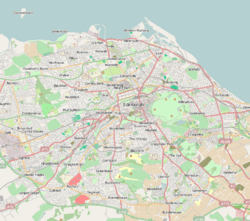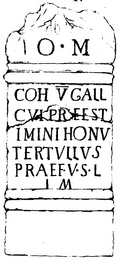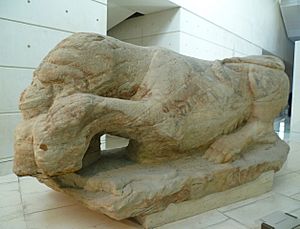Cramond Roman Fort facts for kids
Quick facts for kids Cramond Roman Fort |
|
|---|---|
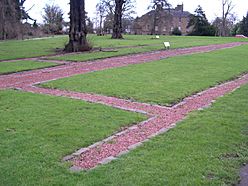
Site of the Roman fort at Cramond
|
|
| Alternative name(s) | Carumabo?, Rumabo? |
| Founded | c. 140 AD |
| Abandoned | 4th century AD |
| Attested by | Ravenna Cosmography? |
| Stationed military units | |
| — Legions — | |
| vexill. II Augusta | |
| — Cohorts — | |
|
|
| Location | |
| Coordinates | 55°58′39″N 3°17′48″W / 55.9774°N 3.2967°W |
| Town | Edinburgh |
| Country | Scotland |
| Reference | |
| UK-OSNG reference | NT1976 |
Cramond Roman Fort is a Roman-Era archaeological site at Cramond, Edinburgh, Scotland. The settlement may be the "Rumabo" listed in the 7th-century Ravenna Cosmography. The fort was established around 140 AD and occupied until around 170, with a further period of occupation from around 208 to 214. Among the many archaeological finds, one of the most famous is a sculpture known as the Cramond Lioness.
Contents
History
The fort at Cramond was located on the River Almond at the point where it flows into the Forth. In Roman times, there was probably a natural harbour here. One suggested interpretation is that Cramond formed a chain of Lothian forts along with Carriden and Inveresk. The fort was established around 140 during the building of the Antonine Wall, and remained in use until around 170 when the Romans retreated south to Hadrian's Wall. When the Roman Emperor Septimius Severus began the last major Roman incursion into Scotland from 205 to 214, the fort was reoccupied and enlarged. Throughout these periods of occupation a civilian settlement seems to have existed outside the fort, and some native occupation of the fort seems to have taken place after the time of Severus into the 4th/5th century and during the early Sub-Roman period. Several Roman inscriptions have been found around Crammond.
Finds
A stone altar which was dug up a few hundred years ago in the grounds of Cramond House, was originally erected by a cohort of Tungrians (either first or second) and was dedicated to "the Alatervan Mothers and the Mothers of the Parade-ground" (Latin: Matres Alatervae et Matres Campestres). Early antiquarians interpreted this as referring to the place where the stone was found, and drew from it the conclusion that the Roman name of Cramond was "Alaterva". This idea is no longer accepted among scholars, and "Alatervae" is now believed to be an epithet attached to the Matronae, following a practice found elsewhere in the empire. It is thought that Cramond may be the "Rumabo" listed in the 7th-century Ravenna Cosmography – the original form of the name perhaps being "Carumabo".
Other stones found at the fort include a centurial stone of Legio II Augusta, and an altar "To Jupiter Optimus Maximus" erected by the fifth cohort of Gauls.
The most famous sculpture is the Cramond Lioness recovered from the mouth of the River Almond in 1997. The sculpture, in a non-local white sandstone, shows a lioness devouring her prey, a naked bearded male torso. The sculpture was probably part of a large tomb monument of an important Roman officer, perhaps the fort commander or an important dignitary.
The site today
The ground plan of part of the fort is laid out in an area of open parkland. Here one can see headquarters building, granaries, workshop, together with other buildings, restored in outline. Information panels at the site link the findings of the last 50 years of excavations and recreate life in the former Roman headquarters and bathhouse.
Since 2000 there have been plans to turn the Roman remains at Cramond into a tourist attraction. The plans include a visitor centre and museum, housing most of the Roman artefacts discovered in the area over the years, including the Cramond Lioness.
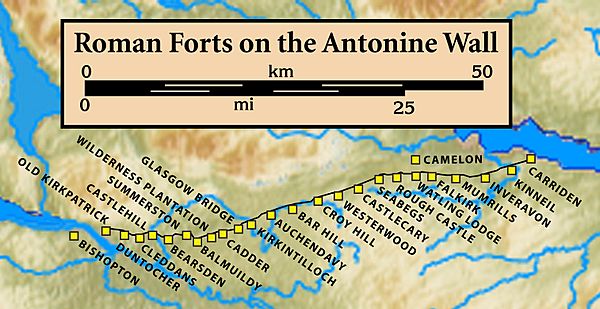
See also
 In Spanish: Fuerte Romano de Cramond para niños
In Spanish: Fuerte Romano de Cramond para niños


